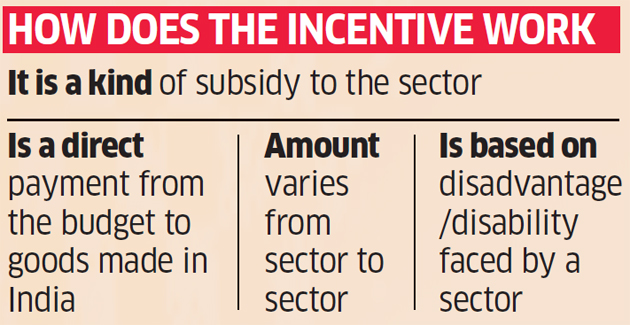PLI Scheme for Ten More Sectors | 12 Nov 2020
Why in News
The Union Cabinet has given its approval to introduce the Production-Linked Incentive (PLI) Scheme in 10 more sectors for enhancing India’s manufacturing capabilities and exports (Atmanirbhar Bharat).
- Earlier, the government had announced a production linked incentive or PLI scheme for medical devices, mobile phones and specified active pharmaceutical ingredients, with a proposed outlay of Rs. 51,311 crore.
Key Points
- PLI Scheme:
- A scheme that aims to give companies incentives on incremental sales from products manufactured in domestic units.
- The scheme invites foreign companies to set units in India, however, it also aims to encourage local companies to set up or expand existing manufacturing units.
- Expansion of PLI Scheme to Ten More Sectors:
- The ten sectors include food processing, telecom, electronics, textiles, specialty steel, automobiles and auto components, solar photo-voltaic modules and white goods such as air conditioners and LEDs.
- The sectors had been identified on the basis of their potential to create jobs and make India self-reliant.
- The PLI scheme for these ten sectors will be operational for five years with a total estimated outlay of Rs 1.45 lakh crore.
- The PLI scheme will be implemented by the concerned ministries/departments.
- Savings from one PLI scheme of an approved sector can be utilized to fund another sector.
- The scheme for these sectors will be in addition to the PLI schemes for mobile phones and allied equipment manufacturing, pharmaceutical ingredients and medical devices.
- Several more pharmaceutical products have been brought under the aegis of the PLI scheme, including complex generics, anti-cancer and diabetic drugs, in-vitro diagnostic devices and special empty capsules.
- Benefits: The PLI scheme across these 10 key specific sectors will make Indian manufacturers globally competitive, attract investment in the areas of core competency and cutting-edge technology; ensure efficiencies; create economies of scale; enhance exports and make India an integral part of the global supply chain.
- Push to Digital Economy:
- India is expected to have a USD 1 trillion digital economy by 2025. Additionally, the Government's push for data localization, Internet of Things, projects such as Smart City and Digital India are expected to increase the demand for electronic products.
- Increase Exports:
- The Indian pharmaceutical industry is the third largest in the world by volume and 14th largest in terms of value. It contributes 3.5% of the total drugs and medicines exported globally.
- India is the world's second largest steel producer in the world. It is a net exporter of finished steel. A PLI scheme in Specialty Steel will help in enhancing manufacturing capabilities for value added steel leading to increase in total exports.
- Specialty steel is made by adding various elements to iron, to achieve various properties, such as heat resistance, hardness, and corrosion resistance.
- Secure Telecom Infrastructure:
- Telecom equipment forms a critical and strategic element of building a secured telecom infrastructure and India aspires to become a major original equipment manufacturer of telecom and networking products.
- Doubling Farmers’ Income:
- The growth of the processed food industry leads to better price for farmers and reduces high levels of wastage.
- Push to Digital Economy:
Way Forward
- Growth in production and exports of industrial goods will greatly expose the Indian industry to foreign competition and ideas, which will help in improving its capabilities to innovate further.
- Promotion of the manufacturing sector and creation of a conducive manufacturing ecosystem will not only enable integration with global supply chains but also establish backward linkages with the MSME sector in the country.
- It will lead to overall growth in the economy and create huge employment opportunities.

